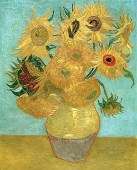Preserving van Gogh's priceless masterpieces

The chrome yellow pigment that renowned post-Impressionist artist Vincent van Gogh favored in priceless masterpieces like Sunflowers, the Yellow House and Wheatfield with Crows is especially sensitive to certain types of light and should be protected to prevent darkening. That's the conclusion of a series of studies in ACS' journal Analytical Chemistry, which could help preserve masterpieces by van Gogh and contemporaries like Gauguin, Cézanne and others.
Koen Janssens and colleagues explain that the chrome yellow pigment used by van Gogh and others in the 19th and 20th centuries is especially susceptible to darkening. For example, what was once a vibrant yellow sunflower might appear brown and muddied a century later. In previous research in Analytical Chemistry, the scientists found that this alteration is at least partially due to a change in the oxidation state of the chromium in this type of pigment over time. In the current work, they wanted to determine the color change effects of shining different types of light on the yellow pigment.
They conducted laboratory tests with lab-made pigments that were similar in composition to pigments that van Gogh used, as well as a historical paint sample from Rik Wouters, a Belgian artist active in the late 1800s/early 1900s. Those chrome yellow paint samples that also are rich in sulfates were highly susceptible to browning, especially in regular, UV and blue light. The researchers suggest that to prevent darkening, art collectors and gallery owners should minimize their paintings' exposure to light in the blue/violet/ultra-violet range.
More information: "The Degradation Process of Lead Chromate in Paintings by Vincent van Gogh Studied by Means of Spectromicroscopic Methods. Part IV: Artificial Ageing of Model Samples of Co-Precipitates of Lead Chromate and Lead Sulfate" Anal. Chem., Just Accepted Manuscript. DOI: 10.1021/ac3021592
Abstract
Previous investigations about the darkening of chrome yellow pigments revealed that this form of alteration is attributable to a reduction of the original Cr(VI) to Cr(III) and that the presence of sulfur-containing compounds, most often sulfates, plays a key role during this process. We recently demonstrated that different crystal forms of chrome yellow pigments (PbCrO4, PbCr1-xSxO4) are present in Vincent van Gogh paintings. In the present work we show how both the chemical composition and the crystalline structure of lead chromate-based pigments influence their stability. For this purpose, artificially aged oil model samples made with in-house synthesized powders of PbCrO4and PbCr1-xSxO4 were artificially aged and characterized. We observed a profound darkening only for those paint models made with PbCr1-xSxO4, rich in SO42- (x≥0.4) and orthorhombic phases (>30 wt.%). Cr and S K-edge micro X-ray absorption near edge structure (µ-XANES) investigations revealed in an unequivocal manner the formation of up to about 60% of Cr(III)-species in the outer layer of the most altered samples; conversely, independent of the paint models' chemical composition, no change in the S-oxidation state was observed. Analyses employing UV-visible diffuse reflectance and Fourier Transform infrared (FTIR) spectroscopy were performed on (un)aged model samples in order to obtain additional information on the physico-chemical changes induced by the ageing treatment.
Journal information: Analytical Chemistry
Provided by American Chemical Society




















